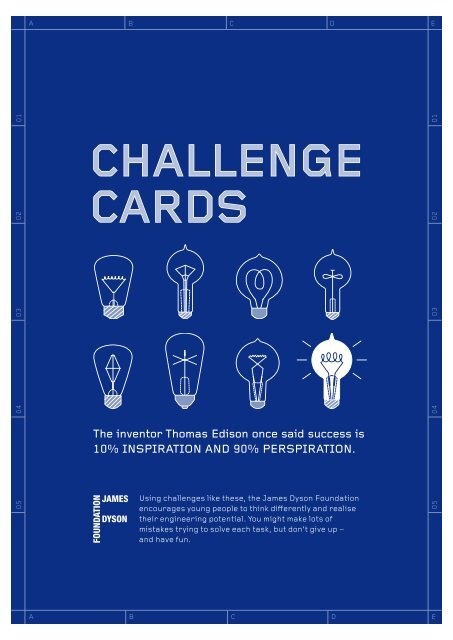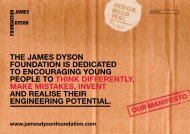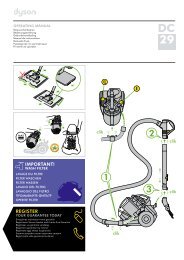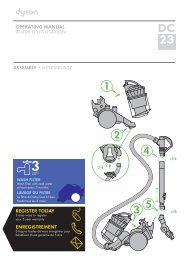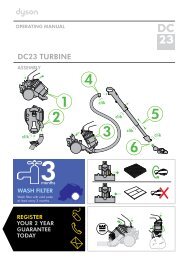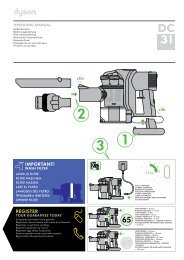challenges - Dyson
challenges - Dyson
challenges - Dyson
Create successful ePaper yourself
Turn your PDF publications into a flip-book with our unique Google optimized e-Paper software.
02 01<br />
03<br />
04<br />
05<br />
A B C D E<br />
CHALLENGE<br />
CARDS<br />
The inventor Thomas Edison once said success is<br />
10% INSPIRATION AND 90% PERSPIRATION.<br />
Using <strong>challenges</strong> like these, the James <strong>Dyson</strong> Foundation<br />
encourages young people to think differently and realise<br />
their engineering potential. You might make lots of<br />
mistakes trying to solve each task, but don’t give up –<br />
and have fun.<br />
A B C D E<br />
02 01<br />
03<br />
04<br />
05
02 01<br />
03<br />
04<br />
05<br />
A B C D E<br />
CHALLENGE<br />
01<br />
SPAGHETTI BRIDGES<br />
Isambard Kingdom Brunel was the genius behind the<br />
Great Western Railway – the series of tunnels and<br />
bridges connecting London with the South West and<br />
Wales. Through years of testing and exploration, he<br />
developed an expert understanding of the strengths<br />
and constraints of materials and the structural stability<br />
of different shapes.<br />
CONSTRUCT A BRIDGE OUT OF<br />
SPAGHETTI, STRONG ENOUGH TO<br />
SUPPORT A 250G BAG OF SUGAR.<br />
Snap. Snap. Start again.<br />
Bridges manage two important forces:<br />
compression and tension – pushing and pulling.<br />
Too much of either and they buckle or snap.<br />
Be patient. Through trial and error, you’ll<br />
become proficient with spaghetti: bracing<br />
strands together for strength; forming rigid<br />
shapes that absorb loads; and using elastic<br />
bands at junctions.<br />
VISIT WWW.JAMESDYSONFOUNDATION.CO.UK/DRAWING<br />
to see more spaghetti bridges, upload your engineering feats<br />
and download your bridge building certificate.<br />
BEAM BRIDGE TRUSS BRIDGE<br />
ARCH BRIDGE CANTILEVER BRIDGE<br />
CABLE-STAYED BRIDGE SUSPENSION BRIDGE<br />
Materials<br />
Spaghetti<br />
Small elastic bands or bag ties<br />
Sticky tape<br />
Plenty of patience<br />
TENSION<br />
COMPRESSION<br />
A B C D E<br />
02 01<br />
03<br />
04<br />
05
02 01<br />
03<br />
04<br />
05<br />
A B C D E<br />
CHALLENGE<br />
02<br />
CHANGING STATES<br />
Rubber is everywhere now. But in the early 1830s it was<br />
considered useless. It set hard in winter and melted in<br />
summer. Charles Goodyear spent nine years finding a<br />
solution. He mixed rubber with other substances; boiled<br />
it; covered it in acid. By chance he dropped a sulphurcovered<br />
sample on a hot stove – transforming it into a<br />
springy substance known today as vulcanised rubber.<br />
HOW DO YOU CHANGE AN<br />
EGG’S PROPERTIES TO<br />
MAKE IT FIT IN A BOTTLE?<br />
Changing the state of the egg:<br />
Boil an egg in a pan of water for 10 minutes and<br />
carefully remove its shell.<br />
Alternatively, for a more challenging approach, try<br />
submerging the egg in a glass of vinegar for up to two<br />
days. When you take it out, the shell will have changed<br />
state and the egg will be surprisingly rubbery.<br />
How it works<br />
Eggs are rich in protein. When heat is applied, chemical<br />
bonds within the protein molecules are broken, and<br />
new bonds are formed between adjacent molecules.<br />
This creates a network of interconnected proteins<br />
which causes the egg to go hard.<br />
Vinegar contains acetic acid (CH 3 COOH) that<br />
dissolves the calcium carbonate (CaCO 3 ) shell but<br />
leaves behind the egg’s springy membrane.<br />
VISIT WWW.JAMESDYSONFOUNDATION.CO.UK/DRAWING<br />
to see more eggy experiments. You can also get a certificate<br />
for completing your experiments successfully.<br />
Materials<br />
1 x small uncooked egg<br />
1 x pan of boiling water (with adult supervision)<br />
or 1 x glass of vinegar<br />
1 x thick-necked bottle<br />
Heat the bottle in hot water – use gloves (or a tea towel)<br />
when handling the hot bottle. Rest the egg on the neck.<br />
As the air inside the bottle cools, it contracts and sucks<br />
the egg down. Tip: try lubricating the egg with kitchen oil<br />
or washing up liquid.<br />
CH 3 COOH<br />
CH 3 COOH<br />
A B C D E<br />
CaCO 3<br />
CH 3 COOH<br />
CH 3 COOH<br />
CO 2 + H 2 O<br />
CO 2 + H 2 O<br />
(CH 3 COO) 2 Ca<br />
CO 2 + H 2 O<br />
CO 2 + H 2 O<br />
02 01<br />
03<br />
04<br />
05
02 01<br />
03<br />
04<br />
05<br />
A B C D E<br />
CHALLENGE<br />
03<br />
GEODESIC DOME<br />
Richard Buckminster Fuller studied beehives, fishing<br />
nets and other ‘networks’ to create the geodesic dome:<br />
lightweight, simple to build, yet incredibly rigid – ideal<br />
for the post WW2 housing shortage. Today, there are<br />
more than 300,000 around the world.<br />
USING JELLY SWEETS AND<br />
COCKTAIL STICKS, MAKE<br />
YOUR OWN GEODESIC DOME.<br />
Follow the steps 1 to 6.<br />
You’ll need two different cocktail stick lengths:<br />
35 at 60mm and 30 cut down to 54mm.<br />
Key for cocktail stick lengths:<br />
60mm<br />
54mm<br />
Why are geodesic domes so rigid?<br />
Multiple, interlocked triangles form incredibly strong<br />
structures. To deform or buckle a triangle you have to<br />
compress or stretch the lengths of the sides, which is<br />
hard to do as they all support each other. Ideal for<br />
polar research stations and military bases.<br />
Domes and more<br />
Try making a bigger dome. More triangles means<br />
greater rigidity and a smoother curve. See what<br />
other structures you can make using cocktail<br />
sticks and jelly sweets.<br />
VISIT WWW.JAMESDYSONFOUNDATION.CO.UK/DRAWING<br />
to see other geodesic domes, or upload your own structures.<br />
Once your dome is built, you can download a certificate.<br />
Materials<br />
Cocktail sticks<br />
Jelly sweets<br />
Scissors (with adult supervision)<br />
3 4<br />
1 2 5 6<br />
A B C D E<br />
02 01<br />
03<br />
04<br />
05
02 01<br />
03<br />
04<br />
05<br />
A B C D E<br />
CHALLENGE<br />
04<br />
MARBLE RUN<br />
Cardboard is a useful material for <strong>Dyson</strong> engineers.<br />
It’s pliable, easy to shape and ideal for prototyping<br />
and early structural testing. It’s also recyclable.<br />
USE YOUR VACUUM CLEANER<br />
BOX AND THE INTERNAL<br />
CARDBOARD STRUTS TO<br />
CREATE A MARBLE RUN.<br />
Marble run physics<br />
To help you control the time your marble takes to run<br />
its course, you will need to consider the following:<br />
VISIT WWW.JAMESDYSONFOUNDATION.CO.UK/DRAWING<br />
to be inspired by other marble runs. You can also upload<br />
footage of your own and get a certificate for your efforts.<br />
Materials<br />
Vacuum cleaner box (including inner struts)<br />
Sticky tape<br />
Marbles<br />
Scissors (with adult supervision)<br />
Try to keep the marble moving for 60 seconds by<br />
making the course longer or slowing the marble.<br />
POTENTIAL ENERGY = MASS X GRAVITY X HEIGHT<br />
The heavier your marble, and higher your slope,<br />
the more energy your marble will have.<br />
ANGLE OF SLOPE<br />
For a given slope height,<br />
the smaller the slope<br />
angle, the longer the<br />
marble will take to<br />
reach the bottom.<br />
FRICTION<br />
A rougher or stickier surface<br />
will slow your marble down.<br />
A B C D E<br />
02 01<br />
03<br />
04<br />
05


